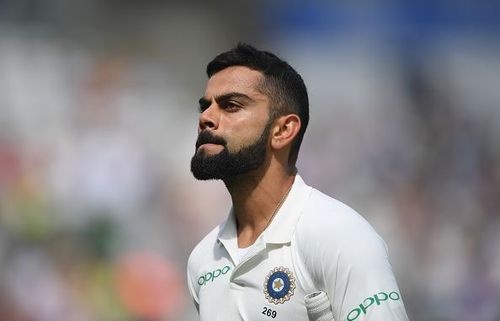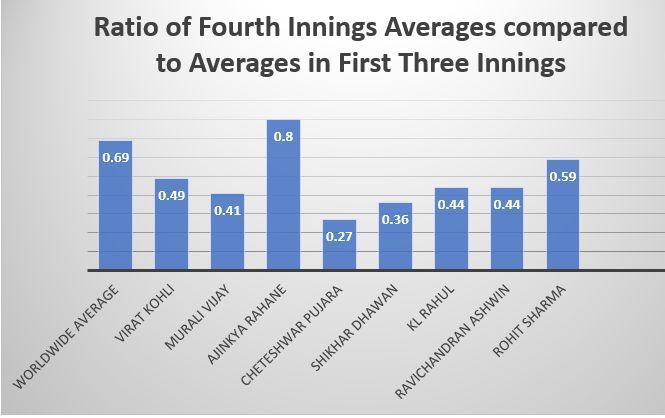
England vs India 2018: India's fourth innings malaise continues

When Virat Kohli was asked after the first innings of the Edgbaston Test if this was his best knock, he replied that it would likely be second to the knock he played in the second innings in Adelaide. Little did he know that by the end of this game at Edgbaston, he would have horrible flashbacks of that game in 2014, also his first as captain.
That Test (like this one) was an all-time classic. Played after the tragic death of Phillip Hughes, it was a high-scoring game that saw Australia set India an imposing total of 364 for the fourth innings chase on the final day. Making 364 in the fourth innings is hard enough, but doing it within a day is nearly impossible.
For a while, it seemed as if India were going to achieve a miracle. With 29 overs to go, India only needed 122 runs with eight wickets in hand. Virat Kohli had reached his century and Murali Vijay was nearing his, at 99. Yet, Nathan Lyon trapped Vijay at 99, sparking a horrible collapse of 73 runs for eight wickets.
India had had traumatizing chases before: the Bridgetown Test in 1997 is a perfect example. However, the Adelaide Test displayed a new team- with a sense of fearlessness (or recklessness depending on your perspective) that was last seen by India under the captaincy of Sourav Ganguly.
For the most part, this has been true- Kohli’s win percentage as captain has been 58.33%- highest among Indian captains to have skippered more than five Tests (this and all statistics to follow are from ESPNCricinfo). Thus, one would have expected that India would chase well under Kohli- however that hasn’t been the case.
India have only won one of their nine chases under Kohli's tenure while losing six. A rather stirring example is the Galle 2015 Test when Sri Lanka staged one of the great Test match comebacks as India abysmally failed to reach a target of 176.
This tendency to collapse was also evident in Pune, Centurion, Cape Town and now Edgbaston. In two of these cases, the target was less than 200- a situation where they should have been favorites. In an additional two situations, they were chasing less than 300- still easily achievable.
So why have India struggled so much chasing targets? After all, they have a brilliant batting lineup, which has succeeded in almost all conditions. Moreover, they have the greatest ODI chaser ever in Virat Kohli. Why hasn’t he and the rest of the team managed to replicate that in Test match cricket?
Some would argue that the difficulty of the fourth innings is why they have failed in such chases. However, the success rate is so abysmal. India’s batsmen have also struggled in comparison to their peers. If one creates a ratio of batsmen’s (top six players) average in the first three innings in comparison to their performance in the fourth innings, then this is how Indian batsmen (players who have batted in the top six for more than ten innings since the start of 2015) fare:

As one can see, only Ajinkya Rahane has a higher ratio than the worldwide average. This basically suggests that all other Indian batsmen underperform even when compared to the worldwide norm in fourth innings chases.
There are several possible hypotheses for this issue. One is that Indian batsmen’s performances depend more heavily (when compared to the world) on friendly conditions. Therefore, when pitches start to deteriorate in the fourth innings then their technical deficiencies are exposed in an adverse manner.
This theory sits well with the struggles Indian batsmen have faced in South Africa and now in England (apart from the obvious exception of Kohli). The fact that Rahane is the only one who exceeds the worldwide ratio also supports this, considering the Mumbai batsman’s ability to handle very tough conditions better than most.
Yet, this theory is flawed in the sense that it fails to explain why Indian batsmen’s performances deteriorate in fourth innings even more than the rest of the world. After all batsmen like Kohli, Pujara, Rahul, Vijay and Rahane are probably more technically sound than the average batsman worldwide.
Instead, the issue may be mental: the frequencies of these collapses and India’s relative success in the first three innings is simply too much to be explained by technical issues. After all what else can explain Rahul’s shot at Edgbaston? Or Vijay leaving a straight ball? In every unsuccessful chase, usually sensible batsmen make such inexplicable decisions.
Yet to attribute the entire failings of a batting order to “mental issues” seems absurd. After all, many of these batsmen have played a major part in India’s famous ODI chases over the past half-decade. In truth, it is probably a combination of these technical and mental factors that has doomed India in the fourth-innings.
India’s current Test team has the ability to achieve great things- they are already at No.1 and can establish themselves as a great all-time Test team. For them to do that, their difficulties chasing will need to be eliminated.